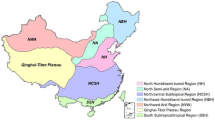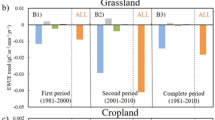Abstract
The Simple Biosphere Model (SiB2) and the 2 × 2 km resolution National Land use/Land Cover database were used to investigate the effects of Land Use/Cover Change (LUCC) on land surface energy balance and climate in Jilin Province, northeast China, from 1990 to 2005. The spatial patterns of the components of surface energy balance (i.e., net radiation (R n), latent heat (LH), sensible heat (SH), and albedo (α)) and climate (i.e., canopy temperature (T c), diurnal temperature range (DTR)), as well as the roles of land cover type in variations of energy balance and climate, were investigated. The results showed that there were general similar trends in R n, LH, SH, and α in the LUCC process. The spatial patterns of T c and DTR also showed consistent relationships with LUCC processes. Leaf area index (LAI) and canopy conductance (g c) were found to be the key factors in controlling the spatial patterns of the components of surface energy balance and T c. Using linear correlation method, the gaps of the components of surface energy balance were well-explained by the differences of LAI and g c, and R n had a better correlation with T c and DTR, in the process of LUCC. The surface energy partitioning of R n into LH and SH could not only dampen or strengthen the temperature difference, but also change the relative size of albedo-based R n when the albedo gap was small, between land cover types.





Similar content being viewed by others
References
Avila F, Pitman A, Donat M, Alexander L, Abramowitz G (2012) Climate model simulated changes in temperature extremes due to land cover change. J Geophys Res 117:D04108. doi:10.1029/2011jd016382
Baldocchi DD, Vogel CA, Hall B (1997) Seasonal variation of energy and water vapor exchange rates above and below a boreal jack pine forest canopy. J Geophys Res 102:28939–28951
Baldocchi DD, Xu L, Kiang N (2004) How plant functional-type, weather, seasonal drought, and soil physical properties alter water and energy fluxes of an oak-grass savanna and an annual grassland. Agr Forest Meteorol 123:13–39
Barr A, Black TA, McCaughey H (2009) Climatic and phenological controls of the carbon and energy balances of three contrasting boreal forest ecosystems in western Canada. Pages. In Phenology of Ecosystem Precesses (pp. 3–34). Springer New York
Betts RA (2001) Biogeophysical impacts of land use on present-day climate: near-surface temperature change and radiative forcing. Atmos Sci Lett 2:39–51
Betts RA, Falloon PD, Goldewijk KK, Ramankutty N (2007) Biogeophysical effects of land use on climate: model simulations of radiative forcing and large-scale temperature change. Agric For Meteorol 142:216–233
Betts AK, Desjardins R, Worth D, Cerkowniak D (2013) Impact of land use change on the diurnal cycle climate of the Canadian Prairies. J Geophys Res 118(21):11,996–12,011
Boisier JP, de Noblet-Ducoudré N, Pitman AJ, Cruz FT, Delire C, van den Hurk BJJM, van der Molen MK, Müller C, Voldoire A (2012) Attributing the impacts of land-cover changes in temperate regions on surface temperature and heat fluxes to specific causes: results from the first LUCID set of simulations. J Geophys Res 117:D12116. doi:10.1029/2011JD017106
Bonan GB (2002) Ecological climatology: concepts and applications: Cambridge University Press
Bonan GB (2008) Forests and climate change: forcings, feedbacks, and the climate benefits of forests. Science 320:1444–1449
Bonan GB (2013) Biogeophysical feedbacks between land cover and climate. In: Defries RS, Asner GP, Houghton RA (eds) Ecosystems and land use change. American Geophysical Union, Washington, DC, pp 61–72. doi:10.1029/153GM06
Bounoua L, Masek J, Tourre YM (2006) Sensitivity of surface climate to land surface parameters: a case study using the simple biosphere model SiB2. J Geophys Res 111(D22S09):1984–2012. doi:10.1029/2011JD016382
Cesaraccio C, Spano D, Duce P, Snyder RL (2001) An improved model for determining degree-day values from daily temperature data. Int J Biometeorol 45:161–169
Christidis N, Stott PA, Hegerl GC, Betts RA (2013) The role of land use change in the recent warming of daily extreme temperatures. Geophys Res Lett 40(3):589–594
Collatz GJ, Ball JT, Grivet C, Berry JA (1991) Physiological and environmental regulation of stomatal conductance, photosynthesis and transpiration: a model that includes a laminar boundary layer. Agric For Meteorol 54(2–4):107–136
Collatz GJ, Ribas-Carbo M, Berry JA (1992) Coupled photosynthesis-stomatal conductance model for leaves of C4 plants. Aust J Plant Physiol 19:519–538
Dai A, Trenberth KE, Karl TR (1999) Effects of clouds, soil moisture, precipitation, and water vapor on diurnal temperature range. J Clim 12:2451–2473
Dong SY, Yan XD, Xiong Z (2013) Varying responses in mean surface air temperature from land use/cover change in different seasons over Northern China. Acta Ecol Sin 33(3):167–171
Falge E, Tenhunen J, Baldocchi D, Aubinet M, Bakwin P (2002) Phase and amplitude of ecosystem carbon release and uptake potentials as derived from FLUXNET measurements. Agric For Meteorol 113(1):75–95
Feddema J, Oleson K, Bonan G, Mearns L, Washington W, Meehl G, Nychka D (2005) A comparison of a GCM response to historical anthropogenic land cover change and model sensitivity to uncertainty in present-day land cover representations. Clim Dyn 25:581–609
Gao X, Luo Y, Lin W, Zhao Z, Filippo G (2003) Simulation of effects of land use change on climate in China by a regional climate model. Adv Atmos Sci 20:583–592
Gu L, Meyers T, Pallardy SG, Hanson PJ, Yang B, Heuer M, Hosman KP, Riggs JS, Sluss D, Wullschleger SD (2006) Direct and indirect effects of atmospheric conditions and soil moisture on surface energy partitioning revealed by a prolonged drought at a temperate forest site. J Geophys Res 111:D16102. doi:10.1029/2006JD007161
Hammerle A, Haslwanter A, Tappeiner U, Cernusca A, Wohlfahrt G (2008) Leaf area controls on energy partitioning of a temperate mountain grassland. Biogeosciences 5:421–431
Hanan NP, Berry JA, Verma SB, Walter-Shea EA, Suyker AE, Burba GG, Denning AS (2005) Testing a model of CO2, water and energy exchange in great plains tallgrass prairie and wheat ecosystems. Agric For Meteorol 131:162–179
IPCC (2007) Climate change 2007. In: Solomon S, Qin D, Manning M, Chen Z, Marquis M, Averyt KB, Tignor M, Miller HL (eds) The physical science basis. Contribution of working group I to the fourth assessment report of the intergovernmental panel on climate change. Cambridge University Press, Cambridge
Iritz Z, Lindroth A (1996) Energy partitioning in relation to leaf area development of short-rotation willow coppice. Agric For Meteorol 81:119–130
Kimball JS, Running SW, Nemani R (1997) An improved method for estimating surface humidity from daily minimum temperature. Agric For Meteorol 85:87–98
Lawrence PJ, Chase TN (2010) Investigating the climate impacts of global land cover change in the community climate system model. Int J Climatol 30:2066–2087
Li SG, Eugster W, Asanuma J, Kotani A, Davaa G, Oyunbaatar D, Sugita M (2006) Energy partitioning and its biophysical controls above a grazing steppe in central Mongolia. Agric For Meteorol 137:89–106
Li Y, Zhou L, Xu Z, Zhou G (2009) Comparison of water vapour, heat and energy exchanges over agricultural and wetland ecosystems. Hydrol Process 23:2069–2080
Liang SL, Xiao ZQ (2012) Global land surface products: leaf area index product data collection(1985–2010). Beijing, China: Beijing Normal University, http://www.bnu-datacenter.com/
Liu JY, Liu ML, Deng XZ, Zhuang DF, Zhang ZX, Luo D (2002) The land use and land cover change database and its relative studies in China. J Geogr Sci 12:275–282
Liu JY, Zhang ZX, Xu XL, Kuang WH, Zhou WC, Zhang SW, Li RD, Yan CZ, Yu DS, Wu SX, Jiang N (2009) Spatial patterns and driving forces of land use change in China in the early 21st century. Acta Geograph Sin 64:1411–1420 (in Chinese with English abstract)
Liu FS, Tao FL, Xiao DP, Zhang S, Wang M, Zhang H (2014) The influence of land use change on surface energy balance and climate: results from SiB2 model simulation. Prog Geogr 33:815–824
Mahmood R, Pielke RA, Hubbard KG, Niyogi D, Dirmeyer PA, McAlpine C, Carleton AM, Hale R, Gameda S, Beltrán‐Przekurat A (2013) Land cover changes and their biogeophysical effects on climate. Int J Climatol 34:929–953. doi:10.1002/joc.3736
Pielke R, Adegoke J, Beltran‐Przekurat A, Hiemstra C, Lin J, Nair U, Niyogi D, Nobis T (2007) An overview of regional land-use and land-cover impacts on rainfall. Tellus B 59:587–601
Pongratz J, Bounoua L, DeFries RS, Morton DC, Anderson LO, Mauser W, Klink CA (2006) The impact of land cover change on surface energy and water balance in Mato Grosso, Brazil. Earth Interact 10:1–17
Potter CS, Randerson JT, Field CB, Matson PA, Vitousek PM, Mooney HA, Klooster SA (1993) Terrestrial ecosystem production: a process model based on global satellite and surface data. Global Biogeochem Cycles 7:811–841
Puma MJ, Koster RD, Cook BI (2013) Phenological versus meteorological controls on land-atmosphere water and carbon fluxes. J Geophys Res Biogeosci 118:14–29
Revfeim KJA (1997) On the relationship between radiation and mean daily sunshine. Agric For Meteorol 86:183–191
Sellers PJ (1985) Canopy reflectance, photosynthesis and transpiration. Int J Remote Sens 6:1335–1372
Sellers PJ, Randall D, Collatz G, Berry J, Field C, Dazlich D, Zhang C, Collelo G, Bounoua L (1996a) A revised land surface parameterization (SiB2) for atmospheric GCMs. Part I: model formulation. J Clim 9:676–705
Sellers PJ, Tucker CJ, Collatz GJ, Los SO, Justice CO, Dazlich DA, Randall DA (1996b) A revised land surface parameterization (SiB2) for atmospheric GCMs. Part II: the generation of global fields of terrestrial biophysical parameters from satellite data. J Clim 9:706–737
Tang Q, Oki T, Kanae S (2006) A distributed biosphere hydrological model (DBHM) for large river basin. P Hydraul Eng 50:37–42
Teuling AJ, Seneviratne SI, Stockli R, Reichstein M, Moors E, Ciais P, Luyssaert S, van den Hurk B, Ammann C, Bernhofer C, Dellwik E, Gianelle D, Gielen B, Grunwald T, Klumpp K, Montagnani L, Moureaux C, Sottocornola M, Wang L, Koike T, Yang D, Yang K (2009) Improving the hydrology of the simple biosphere model 2 and its evaluation within the framework of a distributed hydrological model. Hydrol Sci J 54:989–1006
Wang Q, Niu D, Yu G, Ren Z, Wen X, Chen J, Ju W (2004) Simulating the exchange of carbon dioxide, water vapor and heat over Changbai mountains temperate broad-leaved Korean pine mixed forest ecosystem. Sci China Ser D 34:131–140 (in Chinese with English abstract)
Wang YL, Feng JM, Gao H (2013) Numerical simulation of the impact of land cover change on regional climate in China. Theor Appl Climatol 115(1–12):141–152
Yan XD, Li HY, Liu F, Gao ZQ, Liu HZ (2010) Modeling of surface flux in Tongyu using the simple biosphere model 2 (SiB2). J For Res 21(2):183–188
Yang K, Huang GW, Tamai N (2001) A hybrid model for estimating global solar radiation. Sol Energy 70(1):13–22
Zhao S, Fang J, Zong Z, Zhu B, Shen H (2004) Composition, structure and species diversity of plant communities along an altitudinal gradient on the northern slope of Mt. Changbai, Northeast China. Biodivers Sci 12(1):164–173 (in Chinese with English abstract)
Acknowledgments
This study was supported by the National Key Program for Developing Basic Science (Project Number 2010CB950902), China. We thank the anonymous reviewer for the constructive comments and suggestions on our manuscript.
Author information
Authors and Affiliations
Corresponding author
Rights and permissions
About this article
Cite this article
Liu, F., Tao, F., Liu, J. et al. Effects of land use/cover change on land surface energy partitioning and climate in Northeast China. Theor Appl Climatol 123, 141–150 (2016). https://doi.org/10.1007/s00704-014-1340-7
Received:
Accepted:
Published:
Issue Date:
DOI: https://doi.org/10.1007/s00704-014-1340-7




